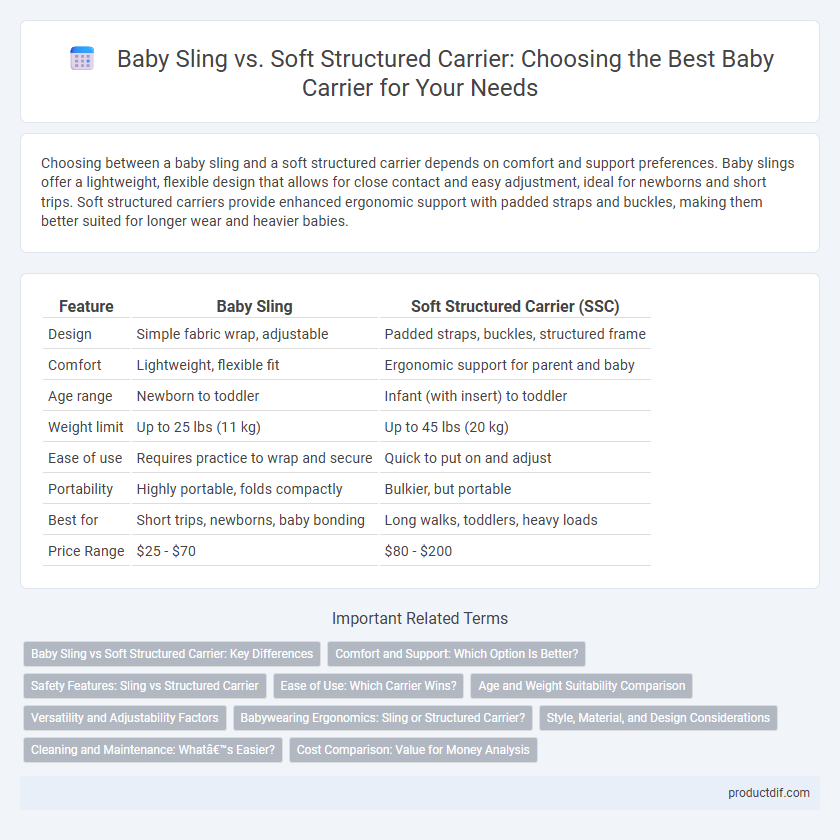Choosing between a baby sling and a soft structured carrier depends on comfort and support preferences. Baby slings offer a lightweight, flexible design that allows for close contact and easy adjustment, ideal for newborns and short trips. Soft structured carriers provide enhanced ergonomic support with padded straps and buckles, making them better suited for longer wear and heavier babies.
Table of Comparison
| Feature | Baby Sling | Soft Structured Carrier (SSC) |
|---|---|---|
| Design | Simple fabric wrap, adjustable | Padded straps, buckles, structured frame |
| Comfort | Lightweight, flexible fit | Ergonomic support for parent and baby |
| Age range | Newborn to toddler | Infant (with insert) to toddler |
| Weight limit | Up to 25 lbs (11 kg) | Up to 45 lbs (20 kg) |
| Ease of use | Requires practice to wrap and secure | Quick to put on and adjust |
| Portability | Highly portable, folds compactly | Bulkier, but portable |
| Best for | Short trips, newborns, baby bonding | Long walks, toddlers, heavy loads |
| Price Range | $25 - $70 | $80 - $200 |
Baby Sling vs Soft Structured Carrier: Key Differences
Baby slings offer versatility with lightweight, fabric designs that allow for various carrying positions and are ideal for newborns, while soft structured carriers provide ergonomic support with padded straps and buckles suited for older babies and toddlers. Soft structured carriers distribute weight evenly across the shoulders and hips, promoting comfort during long wear, whereas baby slings rely on fabric tension and positioning that may require practice for proper use. Choosing between a baby sling and a soft structured carrier depends on factors like baby's age, desired carrying style, and caregiver comfort preferences.
Comfort and Support: Which Option Is Better?
Baby slings provide a snug, womb-like environment that enhances bonding and allows for natural breastfeeding, but may offer less structured support for extended use. Soft structured carriers feature padded shoulder straps and waist belts that distribute baby's weight evenly, reducing strain on the caregiver's back and shoulders. For comfort and ergonomic support during long periods, soft structured carriers are generally considered the superior choice.
Safety Features: Sling vs Structured Carrier
Baby slings offer close physical contact and flexibility but require careful positioning to ensure airway safety and prevent hip dysplasia, emphasizing the caregiver's attentiveness. Soft structured carriers provide ergonomic support with padded shoulder straps, adjustable buckles, and reinforced seating to distribute weight evenly and maintain proper spinal alignment, enhancing overall infant safety. Both safety features hinge on correct usage, but structured carriers generally offer more built-in safeguards for long-term comfort and posture.
Ease of Use: Which Carrier Wins?
Baby slings offer lightweight convenience and quick adjustments, making them ideal for newborns and short trips, while soft structured carriers feature padded straps and buckles that distribute weight evenly for extended wear and better back support. Soft structured carriers typically provide more ergonomic benefits and support for both parent and baby, reducing strain during prolonged use compared to slings. Ease of use depends on the caregiver's experience and activity level, but soft structured carriers often win for secure fit and comfort in everyday use.
Age and Weight Suitability Comparison
Baby slings are ideal for newborns up to 15 pounds, providing a snug, cozy fit that supports infant head and neck development. Soft structured carriers accommodate a broader range, often from 7 to 45 pounds, offering adjustable features to support growing babies and toddlers. Selecting between a sling and a structured carrier depends largely on the child's age and weight, ensuring safety and ergonomic comfort for both baby and caregiver.
Versatility and Adjustability Factors
Baby slings offer lightweight, flexible carrying options ideal for newborns and quick transitions, while soft structured carriers provide enhanced versatility with multiple carrying positions suitable for infants and toddlers. Adjustable straps and buckles on soft structured carriers allow for ergonomic customization, promoting better comfort and support for both baby and caregiver during extended wear. Slings, though adjustable through wrapping techniques, lack the structured support and precise fitting features found in soft structured carriers, impacting long-term versatility.
Babywearing Ergonomics: Sling or Structured Carrier?
Baby slings offer a flexible, close-to-body fit promoting natural hip development and spinal alignment, ideal for newborns and infants. Soft structured carriers provide enhanced support with adjustable straps and lumbar support, distributing weight evenly for older babies and prolonged wear. Ergonomically, slings encourage a natural "M" shaped leg position, while structured carriers maintain optimal posture with padded head and back support.
Style, Material, and Design Considerations
Baby slings offer a lightweight, fabric-based design ideal for quick, hands-free carrying with breathable, soft materials like cotton or linen, perfect for warm climates. Soft structured carriers feature padded straps, buckles, and ergonomic support made from durable yet comfortable materials such as mesh or woven fabric, ensuring greater weight distribution and long-term comfort. Design considerations include the sling's simplicity and compactness for newborns, while structured carriers provide adjustable sizing and enhanced security for toddlers during extended wear.
Cleaning and Maintenance: What’s Easier?
Baby slings, made from lightweight fabrics, are generally easier to clean as they can be machine washed and dry quickly, reducing maintenance time. Soft structured carriers, often featuring padding and buckles, require more careful cleaning, sometimes needing spot cleaning or hand washing specific components to preserve durability. Choosing between them depends on the caregiver's preference for convenience versus structure, with slings offering simpler upkeep and structured carriers demanding more detailed maintenance.
Cost Comparison: Value for Money Analysis
Baby slings often come at a lower price point compared to soft structured carriers, making them a budget-friendly option for parents seeking basic support. Soft structured carriers, while more expensive, offer enhanced ergonomic design, adjustable features, and greater durability, delivering better long-term value despite the higher initial cost. Evaluating the balance between upfront investment and extended usability is crucial for discerning true value for money in babywearing choices.
Baby Sling vs Soft Structured Carrier Infographic

 productdif.com
productdif.com